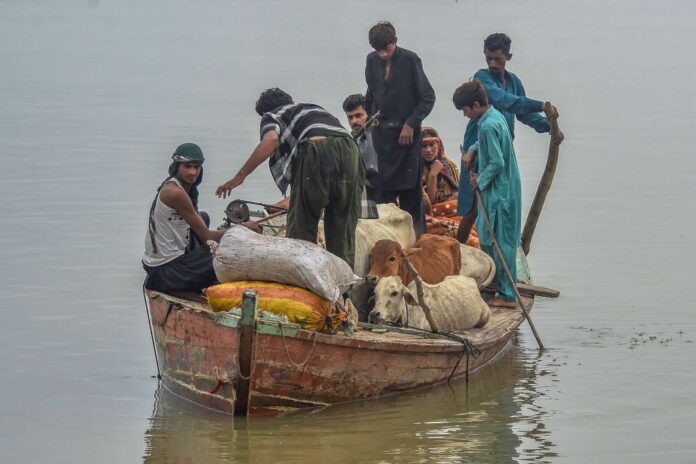LAHORE: As the losses from devastating floods keep piling up, farmers and experts fear that the killing of hundreds of thousands of animals may lead to a severe shortage of milk and meat in the coming months.
Ravaging floods have killed over 1,300 people, ripped away mountainsides, swept off the foundations of buildings, bridges, and roads, and inundated a third of Pakistan since mid-June.
The historic floods and destructive rains have also washed away hundreds of thousands of livestock, a major source of livelihood in rural Pakistan, which makes up 70 percent of the state.
According to the official statistics, over 750,000 animals of different kinds have been killed due to rains and floods, a grim development, which is likely to cause shortages of meat, milk, and other dairy products in a country already facing a looming threat of food insecurity.
Of the total figure, around 70 percent or 500,000 livestock have been washed away by raging floods in the southwestern province of Balochistan, followed by Punjab where over 200,000 animals have been killed since June 14, figures shared by the National Disaster Management Authority (NDMA) said.
Agriculturists and dairy business experts fear that the killing of hundreds of thousands of animals may lead to a 30 percent to 40 percent reduction in milk and meat production in the coming months.
“Our homes have been damaged and (agricultural) lands are under water. We are definitely worried about it,” said Rasool Bux, a farmer from Dadu district of Sindh, who along with his family is currently taking refuge at a school-turned-shelter camp on the southern outskirts of Karachi.
“But I am more worried about my (lost) livestock, which was the backbone of my economy. Farmlands will be again cultivatable once the water recedes, and we can even live in our damaged house. But how will I get back my buffalos, sheep, and cows? That’s the most worrisome issue for me,” Bux told Anadolu Agency.
Number of lost livestock may rise
“The killing of such a huge number of livestock proved to be the last straw that broke the camel’s back for Pakistan’s farmers, whose agriculture lands and entrenched crops have already been destroyed by rains and floods,” observed Shoukat Ali Chadhar, president of Kisan Board of Pakistan, a non-governmental organisation involved in agriculture research.
Almost 45 percent of the country’s cropland has already been inundated by the floods, posing a serious threat to food security and further adding to the already skyrocketing inflation.
Speaking to Anadolu Agency, Chadhar said the number of lost livestock could be even higher as the exact figures are not possible to calculate at this point.
“All the governments and NGOs are engaged in saving human lives and infrastructures. They have no idea what havoc the floods have wreaked on livestock, which is the only source of income for millions of Pakistanis,” he observed.
There is a huge shortage of fodder even for the surviving animals due to inundation of croplands in the floods-battered areas, Chadhar further said, warning that the number of animal casualties might go up to an alarming level if they are not provided food.
The Kisan Board of Pakistan is working solely on the livestock sector, with a special focus on arranging fodder for the surviving animals across the country.
Balochistan hit hardest
The arid Balochistan is the country’s largest province in terms of land but the smallest populated region, where nearly 50 percent of people, mainly in rural and mountainous areas, rely on livestock for their livelihood.
“The people of Balochistan have suffered the most, where all agriculture sectors, particularly livestock, which is the direct source of income for around 50% of the local population, have been hit hard by rains and floods,” said Rasheed Ahmad Nithwani, an agriculturalist from Balochistan.
It is not only rains and floods, according to Nithwani, that have killed animals in every nook and corner of the sprawling province, which makes up 42 percent of Pakistan, but different waterborne diseases and infections are also taking a toll on the livestock.
He said a large chunk of the population in the province’s mountainous regions, which solely depends on livestock, “has gone many years back in terms of economy.”
Supporting Chadhar’s observation, Nithwani, who himself has lost a major chunk of his livestock, said the province is already facing a shortage of milk and meat.
“There is a shortage of meat in many districts of Balochistan. And wherever it is available, prices are higher than normal,” he maintained.
‘Actual brunt is yet to come’
The actual brunt of the losses would be felt after a month, Chadhar said, predicting a 40 percent less production of milk and meat in the country.
“Even the surviving animals won’t be able to produce milk due to unavailability of fodder. Their breeding will also be affected because of that,” he maintained
Pakistan is the fourth largest milk producer country in the world. Around 80 percent of the country’s total production comes from rural areas.
According to the Pakistan Institute of Development Economics (PIDE), an Islamabad-based think tank, livestock, which accounts for 11.2 percent of the nation’s GDP, provides livelihood to over 8 million rural families.
The country produces 50 million tons of milk annually.
In terms of meat production, although the country is not a major world player, it still produces nearly 5 million tons of meat annually.





















